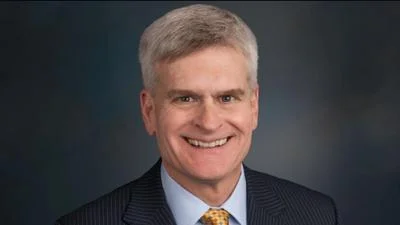The Grassley-Baucus Tax RELIEF Act
Marginal Rate Reductions
The Chairman’s mark cuts individual income taxes across the board. The mark creates a new
10 percent rate that will apply retroactively to the beginning of this year. This new low rate will apply to the first quarter of income that is currently taxed at the 15 percent rate, and the retroactive relief of the 10 percent rate will be reflected in reduced payroll withholdings during the remainder of this year.
For married persons filing joint returns, the upper end of the 15 percent rate bracket will be expanded to include income that is currently taxed at a 28 percent rate. The current 28 percent rate will be reduced to 25 percent, and the current 31 percent rate will fall to 28 percent. The existing
36 percent and 39.6 percent rates will be lowered to 33 percent and 36 percent, respectively. In addition, the current provisions denying a deduction for personal exemptions will be repealed, and the current phase-out for itemized deductions will be partially repealed.
Child Credit
The Chairman’s mark embraces President Bush’s proposal of expanding the child credit to
$1,000. The credit will be phased in. The mark also includes a new proposal that will allow the child credit to benefit working families that would not otherwise receive the child credit under current law because they do not have sufficient (or no) income tax liability.
Marriage Penalty Relief
The Chairman has taken major steps to ensure that income tax relief is provided to married couples - both single and two-earner. The chairman increases the standard deduction for married couples filing jointly to be set at two times that of a single filer. Further, the mark sets the 15 percent rate bracket for married couples filing jointly at two times that of a single filer. These efforts for marriage relief begin in year 2006. Low-income families also will receive tax relief, with an expansion of the Earned Income Credit for married families with children by $3,000 immediately.
Earned Income Credit
Along with the major expansion of the Earned Income Credit (EIC) for married families with children, the Chairman’s mark embraces the major simplification and reform proposals of the EIC program endorsed by the Joint Tax Committee. This simplification will translate into hundreds of thousands more working families with children being eligible for EIC or, if currently using the EIC,
receiving more money.
Death Tax Relief
The Chairman’s mark increases the unified credit (the amount of any estate’s value that isn’t subject to taxes) to $1 million, $2 million, $3 million, and $4 million over next 10 years and ultimately repeals death taxes in 2011. Those are the largest possible jumps allowed under the Senate budget agreement. In 2002, the unified credit amount will be increased to $1 million.
Current law does not provide for the increase until 2006. The top taxable rate immediately will decrease to 50 percent in 2002. Further reductions will be phased in. The Chairman’s mark maintains a full step-up in basis (the way a farm or small business is valued at fair market value for capital gains taxes) prior to repeal while maintaining the gift tax, although rates will decrease.
Retirement Savings
The Chairman’s mark allows Americans to save more money in their retirement plans.
Participants in private sector 401(k), 403(b) plans of non-profit organizations and section 457 plans of state and local governments will be able to save up to $15,000 annually when the limits are fully phased in. Savers in IRAs and Roth IRAs will be able to save up to $5,000 per year under the provisions of the bill. In addition, for savers age 50 and older, catch-up contributions will be allowed. The bill also reduces the amount of time it takes workers to vest their employers’ matching contributions to their accounts from five years to three years.
The bill provides a non-refundable credit to low- and middle-income savers. The credit is contingent upon income and is equal to 50 percent of contributions up to $2,000. The credit could be used for contributions to an IRA, Roth IRA, 401(k) plan, 403(b) plan, 457 or a SIMPLE plan.
In addition, to expand pension plan sponsorship, the mark provides a non-refundable income tax credit for new, small business plans equal to 50 percent of the contributions made for matching contributions to accounts of rank and file workers. A temporary tax credit would also be available to compensate new small business plan sponsors for start-up costs.
Portability of plan assets would be greatly enhanced by this mark. Red tape that has prevented workers in private sector, not-for-profit and the governmental sectors from taking their retirement assets with them from job to job will be eliminated. These changes will reduce pension plan leakage and increase overall retirement savings.
Education Savings
The Chairman’s mark includes a series of education savings provisions approved unanimously by the Finance Committee in March. Provisions include removing the limitation on the deductibility of student loan interest; raising the amount that can be contributed to an education saving account from $500 to $2,000; making distributions from pre-paid college savings plans and tuition plans tax-free; making permanent the tax-free treatment of employer-provided educational assistance; and improving local options for the construction and renovation of public schools.
Alternative Minimum Tax
The mark begins to address the burden of the Alternative Minimum Tax. The mark would allow the child credit to be claimed against the AMT permanently and would repeal the alternative minimum tax offsets of refundable credits. The proposal increases the AMT exemption amount for married couples filing a joint return by $6,000 and by $3,000 for individuals for years 2002 through
2004.
Source: Ranking Member’s News








